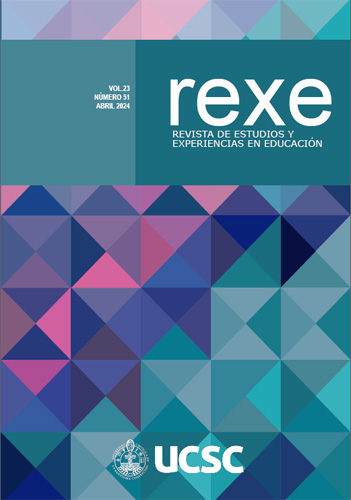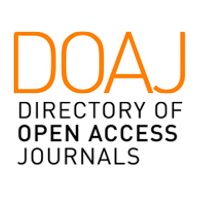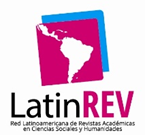Teaching space-time prepositions in English as L2: How do we approach them in the classroom?
DOI:
https://doi.org/10.21703/rexe.v23i51.1708Keywords:
preposiciones, corporeidad, lingüística cognitiva, Enseñanza del Inglés, Adquisición de Segundas LenguasAbstract
Teaching the prepositions in, on and at has been a challenge in the classroom of English as a Second Language. This difficulty can be traced back to the complex nature of the prepositions, since they denote time and space, and, also, do not always have an equivalent in the mother tongue. Prepositions are usually taught explicitly by memorizing rules through visibly concrete examples, or, through implicit teaching where this grammatical axis is not paid attention to. Consequently, the use of prepositions is one of the topics that generate difficulty in the teaching-learning process of English, especially in the first levels of acquisition. Under this scenario, from cognitive linguistics, there are embodiment proposals that seek to conceptualize and explain the essence of space-time prepositions, that is, the "why" of their use. Considering the need to make them known, this article aims to disclose the conceptualization of space-time prepositions in English from an embodiment approach, to facilitate their teaching.
Downloads
References
Aalberse, S., Backus, A., y Muysken, P. (2019). Heritage languages: A language contact approach (Vol. 58). John Benjamins Publishing Company. DOI: https://doi.org/10.1075/sibil.58
Abdalla, I. (2021). Difficulties in using correct English prepositions among EFL students. JEES (Journal of English Educators Society), 6(2). DOI: https://doi.org/10.21070/jees.v6i2.1640
Agencia de Calidad de la Educación. (2017). Informe de Resultados Estudio Nacional Inglés 3º Medio 2017. http://archivos.agenciaeducacion.cl/Informe_Estudio_Nacional_Ingles_III.pdf
Aiblu, A., y Abusnaina, F. (2023). An investigation of the three English Prepositions (In, On, At) and their Meanings in Arabic. Al-Qurtas Journal for Human and Applied Sciences, 2(23), 36-48. https://alqurtas.alandalus-libya.org.ly/ojs/index.php/qjhar/article/view/809
Azizpour, N. (2022). Cognitive science theories: how strong is the relation between connectionism and classical computationalism? Scientific Collection «InterConf», (104), 174-175.
Balboa, M. (2005). Las preposiciones temporales en inglés. Interlingüística, 16(1), 163-170.
Barros, B. (2018). La psicología del desarrollo y el lenguaje. El punto de vista de Jean Piaget (Artículo para conferencia) Cátedra Mario Briceño Iragorry, Universidad Nacional Abierta.
Bayne, T., Brainard, D., Byrne, R. W., Chittka, L., Clayton, N., Heyes, C., y Webb, B. (2019). What is cognition? Current Biology, 29(13), R608-R615. DOI: https://doi.org/10.1016/j.cub.2019.05.044
Bechtel, W., y Abrahamsen, A. (1991). Connectionism and the mind: An introduction to parallel processing in networks. Basil Blackwell.
Bylund, E. y Andersson K. (2015). Las metáforas espacio-temporales y la percepción del tiempo: un estudio comparativo sobre el español y el sueco. En Engwall, Gunnel y Fant, Lars (Eds.) Festival Romanística. Contribuciones lingüísticas, (pp. 113–130). Estocolmo: Stockholm University Press. DOI: http://dx.doi.org/10.16993/bac.f. License: CC-BY DOI: https://doi.org/10.16993/bac.f
Çabuk, S. (2009). The use of prepositions in Second language acquisition process (Tesis de magíster, Middle East Technical University). http://etd.lib.metu.edu.tr/upload/3/12611383/index.pdf
Cacciari, C. y Padovani, R. (2012). The development of figurative language. Cambridge University Press. DOI: https://doi.org/10.1017/CBO9781139029377.026
Cano, B., Hernández, J. y Bacca, J. (2019). Aplicación móvil con Realidad Aumentada para practicar las preposiciones de lugar en inglés: Estudio de usabilidad y aceptación. En Serna, E. (Ed.) Investigación Formativa en Ingeniería. Editorial IAI.
Carter, R. y McCarthy, M. (2008). Cambridge Grammar of English: A comprehensive guide. Cambridge: Cambridge English Language Learning.
Cenoz, J., y Gorter, D. (2020). Teaching English through pedagogical translanguaging. World Englishes, 39(2), 300-311. https://doi.org/10.1111/weng.12462 DOI: https://doi.org/10.1111/weng.12462
Chemero, A. (2013). Radical embodied cognitive science. Review of General Psychology, 17(2), 145-150. DOI: https://doi.org/10.1037/a0032923
Christiani, Z. (2022). Aprendizaje del inglés durante la pandemia de COVID-19. Journal de Ciencias Sociales, 1(18), 125-135. DOI: https://doi.org/10.18682/jcs.vi18.5144
Clark, A. (1999). Estar Ahí. Cerebro, cuerpo y mundo en la nueva ciencia cognitiva. Paidós.
Clark, A. (2023). The experience machine: how our minds predict and shape reality. Pantheon.
Consejo de Europa. (2020). Common European Framework of Reference for Languages: Learning, Teaching, Assessment—Companion Volume. Council of Europe Publishing.
Cortéz, N. y Tunal, G. (2018). Técnicas de enseñanza basadas en el modelo de desarrollo cognitivo. Educación y Humanismo, 20(35), 74-95. DOI: https://doi.org/10.17081/eduhum.20.35.3018
Cronquist, K. y Fiszbein, A. (2017). English language learning in Latin America. Pearson.
de Escudero, E. C., Sastre, M. S., & Loutayf, M. S. (2011). Reading comprehension: Interpretation and translation of metaphors in academic English. Íkala, Revista de Lenguaje y Cultura, 16(1), 77-102 DOI: https://doi.org/10.17533/udea.ikala.8656
De La Nuez, G., Martín, A., Petersen, M., y Guerra, J. (2009). The contribution of cognitive theories in the teaching of time: Towards a new design. En Bretones Callejas, C., Fernández Sánchez J., Ibáñez Ibáñez, J., García Sánchez, M., Cortés de los Ríos, M., Salaberri Ramiro S., Cruz Martínez, M., Perdú Honeyman, N., Cantizano Márquez, B. (Eds.). Applied Linguistics Now: Understanding Language and Mind (pp. 373–384). Almería: AESLA.
de Oliveira, J. R., y Bueno, I. (2021). Proficiência em inglês na América Latina: enfrentando desigualdades. Revista Entre Linguas, e021003-e021003. DOI: https://doi.org/10.29051/el.v7i00.14164
Dixon, R. M. (2021). English prepositions: Their meanings and uses. Oxford University Press. DOI: https://doi.org/10.1093/oso/9780198868682.001.0001
Downing, A., y Locke, P. (2006). A university course (2da ed.) New York: Routledge.
Dunne, B. y Newton, R. (2022a). Get Ready with English 1. Student’s book, English 1º grade. Edición Especial para el Ministerio de Educación. Santiago de Chile: Richmond. Website de Currículum Nacional https://www.curriculumnacional.cl/614/articles-145479_textoescolar_muestra.pdf
Dunne, B. y Newton, R. (2022b). Get Ready with English 2. Student’s book, English 2º grade. Edición Especial para el Ministerio de Educación. Santiago de Chile: Richmond. Website de Currículum Nacional https://www.curriculumnacional.cl/614/articles-182029_textoescolar_muestra.pdf
Dunne, B. y Newton, R. (2022c). Get Ready with English 3. Student’s book, English 3º grade. Edición Especial para el Ministerio de Educación. Santiago de Chile: Richmond. Website de Currículum Nacional https://www.curriculumnacional.cl/614/articles-145482_textoescolar_muestra.pdf
Dunne, B. y Newton, R. (2022d). Get Ready with English 4. Student’s book, English 4º grade. Edición Especial para el Ministerio de Educación. Santiago de Chile: Richmond. Website de Currículum Nacional https://www.curriculumnacional.cl/614/articles-145484_textoescolar_muestra.pdf
Dunne, B. y Newton, R. (2022e). Get Ready with English 5. Student’s book, English 5º grade. Edición Especial para el Ministerio de Educación. Santiago de Chile: Richmond. Website de Currículum Nacional https://www.curriculumnacional.cl/614/articles-145487_textoescolar_muestra.pdf
Dunne, B. y Newton, R. (2022f). Get Ready with English 6. Student’s book, English 6º grade. Edición Especial para el Ministerio de Educación. Santiago de Chile: Richmond.
Escalona, M. y Zamarrón, G. (2022). English Language Proficiency Pre- and Post-Immersion Course in Mexico: The Effectiveness of a Course for Pre-Sessional Students at a Bilingual International and Sustainable University. En J. McKinley y N. Galloway (Eds.), English-Medium Instruction Practices in Higher Education (pp. 239-252). Bloomsbury Publishing. DOI: https://doi.org/10.5040/9781350167889.ch-019
Evans V. y Green, M. (2006). Cognitive Linguistics: An Introduction. Edinburgh: Edinburgh University Press. Chapter 9.
Flavell, J. (2019). El desarrollo cognitivo. Machado Grupo de Distribución, S.L.
Fodor, J. (1983). The modularity of mind. MIT Press. DOI: https://doi.org/10.7551/mitpress/4737.001.0001
Geeraerts D. y Cuyckens, H. (Eds.) (2007). The Oxford Handbook of Cognitive Linguistics. New York: Oxford UP.
Geeraerts, D. (2021). Cognitive semantics. En Xu, W. y Taylor, j. (Eds.). The Routledge Handbook of Cognitive Linguistics (pp. 19-29). Routledge. DOI: https://doi.org/10.4324/9781351034708-3
Getie, A. S. (2020). Factors affecting the attitudes of students towards learning English as a foreign language. Cogent Education, 7(1), 1738184. DOI: https://doi.org/10.1080/2331186X.2020.1738184
González Islas, S., y Reyes-Silva, J. (2020). Geomagnetismo y su influencia en la evolución de las especies. Uno Sapiens Boletín Científico De La Escuela Preparatoria, 1, 3(5), 12-14.
Grady, J. (2007). Metaphor. En Geeraerts D. y Cuyckens, H. (Eds). The Oxford Handbook of Cognitive Linguistics. (pp.188-213). Nueva York: Oxford UP.
Grodal, T. (2009). Embodied visions: Evolution, emotion, culture, and film. Oxford University Press. DOI: https://doi.org/10.1093/acprof:oso/9780195371314.001.0001
Huamán, J. (2021). Causas del bajo dominio del idioma inglés en los estudiantes de secundaria de la Educación Básica Regular en el Perú. Lengua Y Sociedad, 20(1), 125–144. https://doi.org/10.15381/lengsoc.v11i1.22272 DOI: https://doi.org/10.15381/lengsoc.v11i1.22272
Huddleston, R. y Pullum, G. (2002). The Cambridge Grammar of the English Language. Cambridge: Cambridge University Press. https://doi.org/10.1017/9781316423530 DOI: https://doi.org/10.1017/9781316423530
Ibarretxe-Antuñano, I. y Valenzuela, J. (2012). Lingüística Cognitiva. Anthropos.
Johnson, M. (1987). The body in the mind. The bodily basis of meaning, imagination, and reason. University of Chicago Press. DOI: https://doi.org/10.7208/chicago/9780226177847.001.0001
Kosur, H. M. (2008). Form-Function English Grammar Level 1. Rock Pickle Publishing.
Kövecses, Z. (2000). Metaphor: A practical introduction. Oxford UP.
Kövecses, Z. (2022). Some recent issues in conceptual metaphor theory. Researching Metaphors: Towards a Comprehensive Account. DOI: https://doi.org/10.4324/9781003184041-3
Lakoff, G. y Johnson, M. (1980). Metaphors We Live By. Chicago: University Of Chicago Press.
Lakoff, G. y Johnson, M. (2020). Conceptual metaphor in everyday language. En S., Sarasvathy, N., Dew y S., Venkataraman (Eds.), Shaping Entrepreneurship Research Made, as Well as Found (pp. 80-103). Routledge. DOI: https://doi.org/10.4324/9781315161921-4
Lam, Y. (2009). Applying cognitive linguistics to teaching the Spanish prepositions por and para. Language Awareness, 18(1), 2-18. https://doi.org/10.1080/09658410802147345 DOI: https://doi.org/10.1080/09658410802147345
Lindstromberg, S. (1998). English prepositions explained. John Benjamin Publishing Company. DOI: https://doi.org/10.1075/z.88
Ling, Z. (2015). Explicit Grammar and Implicit Grammar Teaching for English Major Students in University. Sino-US English Teaching, 12(8), 556-560. DOI: https://doi.org/10.17265/1539-8072/2015.08.002
Lizasoain, A. (2021). Perfil del profesor de inglés en Chile: quién es y qué enseña. Educar, 57(1), 189-205. https://doi.org/10.5565/rev/educar.1150 DOI: https://doi.org/10.5565/rev/educar.1150
Lorincz, K. y Gordon, R. (2012). Difficulties in Learning Prepositions and Possible Solutions. Linguistic Portfolios, 1, 14. Website de St Cloud State https://repository.stcloudstate.edu/stcloud_ling/vol1/iss1/14
Lyons, J. (1968). Introduction to theoretical linguistics. Cambridge: Cambridge University Press. DOI: https://doi.org/10.1017/CBO9781139165570
Ministerio de Educación. (2015). Bases curriculares 7° básico a 2° medio. Santiago, Chile: Ministerio de Educación. https://www.curriculumnacional.cl/614/articles-37136_bases.pdf
Ministerio de Educación. (2016). Propuesta Curricular 1° básico a 4° básico. Ministerio de Educación chileno.
Ministerio de Educación. (2018). Bases Curriculares Primero a Sexto básico. Ministerio de Educación chileno. https://www.curriculumnacional.cl/portal/Documentos-Curriculares/Bases-curriculares/22394:Bases-Curriculares-1-a-6-basico
Mohammed, M. H. (2018). Challenges of learning English as a Foreign Language (EFL) by non-native learners. International Journal of Social Science and Economic Research, 3(4), 1381-1400. https://ijsser.org/more2018.php?id=97
Moreno, V. A. (2020). La Importancia de la Enseñanza del idioma inglés en la etapa escolar. Alétheia, 8(1), 41–52. https://doi.org/10.33539/aletheia.2020.n8.2422 DOI: https://doi.org/10.33539/aletheia.2020.n8.2422
Mus, M. (2012). The Students’ Ability in Using Preposition A Case Study at Faculty of Letters of Hasanuddin University (Tesis doctoral). Hasanuddin University, Indonesia.
Navarro, I. (2006). On the meaning of three English prepositions. En Navarro, I. y Nieves, C. (Eds.) In-roads of language: essays in English Studies. Castellón de la Plana: Universitat-jaume-i-servei-de-comunicacio-i-publicacions.
Newell, A., y Simon, H. A. (1972). Human problem solving. Prentice-Hall.
Omidian, T., Akbary, M. y Shahriari, H. (2019). Exploring factors contributing to the receptive and productive knowledge of phrasal verbs in the EFL context. Word 65(1), 1-24.https://doi.org/10.1080/00437956.2019.1567040 DOI: https://doi.org/10.1080/00437956.2019.1567040
Ortiz-Correa J., Valenza M., Dreesen T. y Placco, V. (2021). Reopening With Resilience: Lessons from remote learning During COVID-19. Centro de Investigaciones Innocenti de UNICEF. Sitio Web de UNICEF: https://www.unicef-irc.org/publications/1313-reopening-with-resilience-lessons-from-remote-learning-during-covid-19-latin-america-and-the-caribbean.html
Othman, J., y Kiely, R. (2016). Preservice teachers’ beliefs and practices in teaching English to young learners. Indonesian Journal of Applied Linguistics, 6(1), 50–59. https://doi.org/10.17509/ijal.v6i1.2661 DOI: https://doi.org/10.17509/ijal.v6i1.2661
Parrot, M. (2010). Grammar for English Language Teachers. Cambridge English Language Learning. DOI: https://doi.org/10.1017/9781009406536
Piaget, J. (1976). El lenguaje y el pensamiento en el niño (M. Riani, Trad.). Editorial Guadalupe. (Trabajo original publicado en 1968).
Pitura, J. (2022). Developing L2 speaking skills in English-medium EFL higher education. Innovation in Language Learning and Teaching, 16(2), 118-143. https://doi.org/10.1080/17501229.2021.1884688 DOI: https://doi.org/10.1080/17501229.2021.1884688
Pouscoulous, N., y Tomasello, M. (2020). Early birds: Metaphor understanding in 3-year-olds. Journal of Pragmatics, 156, 160-167. DOI: https://doi.org/10.1016/j.pragma.2019.05.021
Ramírez-Romero, J.L., y Sayer, P. (2016). Introduction to the special issue on English language teaching in public primary schools in Latin America. Education Policy Analysis Archives, 24(79). http://dx.doi.org/10.14507/epaa.24.2635 DOI: https://doi.org/10.14507/epaa.24.2635
Real Academia Española, y Asociación de Academias de la Lengua Española. (2011). Nueva Gramática básica de la Lengua Española. Espasa.
Requejo, V. (2020). Las prácticas culturales en el desarrollo cognitivo en la primera infancia. (Tesis de pregrado, Universidad Cooperativa de Colombia). Repositorio Institucional UCC. https://repository.ucc.edu.co/handle/20.500.12494/20436
Ruiz Sanhueza, D., Urrutia, M., Hernández, P. A., y Marrero, H. (2022). Comprensión del tiempo a través del espacio: Un estudio de plasticidad inducida en niños con trastorno del desarrollo del lenguaje. Revista de logopedia, foniatría y audiología, 42(1), 24-34. DOI: https://doi.org/10.1016/j.rlfa.2020.09.005
Setiyadi, A.B. (2020). Teaching English as Foreign Language (2da edición). Graha Ilmu.
Shapiro, L. (2011). Embodied cognition: lessons from linguistic determinism. Philosophical Topics, 121-140. DOI: https://doi.org/10.5840/philtopics201139117
Shapiro, L. (2019). Embodied cognition. Routledge. DOI: https://doi.org/10.4324/9781315180380
Sharkey, A. J., y Sharkey, N. (2019). Connectionism. En The Routledge Companion to Philosophy of Psychology (pp. 180-192). Routledge. DOI: https://doi.org/10.4324/9780429244629-12
Soriano, C. (2003). Some anger Metaphors in Spanish and English. A Contrastive Review. International Journal of English Studies, 3(2), 107-122.
Sweller, J., van Merriënboer, J. J., y Paas, F. (2019). Cognitive architecture and instructional design: 20 years later. Educational psychology review, 31, 261-292. DOI: https://doi.org/10.1007/s10648-019-09465-5
Tejada-Sánchez, I., y Molina-Naar, M. (2020). English medium instruction and the internationalization of higher education in Latin America: A case study from a Colombian university. Latin American Journal of Content & Language Integrated Learning, 13(2), 339-367. DOI: https://doi.org/10.5294/laclil.2020.13.2.8
Thelen, E., y Smith, L. B. (1994). A dynamic systems approach to the development of cognition and action. MIT press. DOI: https://doi.org/10.7551/mitpress/2524.001.0001
Thompson. A. J. y Martinet, A. V. (1986). A practical English grammar (4th ed.). Hong Kong: Oxford University Press.
Tomasello, M. (2005). Constructing a language: A usage-based theory of language acquisition. Harvard university press. DOI: https://doi.org/10.2307/j.ctv26070v8
Tomasello, M. (2009). The cultural origins of human cognition. Harvard University Press. DOI: https://doi.org/10.2307/j.ctvjsf4jc
Urrutia, M., y de Vega, M. (2012). Lenguaje y acción: Una revisión actual a las teorías corpóreas. RLA, Revista de lingüística teórica y aplicada, 50(1), 39-67. DOI: https://doi.org/10.4067/S0718-48832012000100003
Valenzuela Manzanares, J. (2011). Sobre la interacción lengua-mente-cerebro: la metáfora como simulación corporeizada. Revista de Investigación Lingüística, 14, 109-126.
Varela, J., Thompson, E. y Rosch, E. (1993). The embodied mind. Cognitive science and human experience. MIT Press
Wang, Ch. (2020). Implicit Cognitive Meanings of the Spatial Prepositions in, on, and at in English. International Journal of Linguistics and Translation Studies, 1(2) 2020. https://doi.org/10.36892/ijlls.v1i2.33
Wilson, R. A. y Clark, A. (2008). Situated cognition: Letting nature take its course. En Robbins, Ph. y Aydade, M. (Eds). The Cambridge Handbook of Situated Cognition. Cambridge University Press.
Wu, X., Mauraren, A., y Lei, L. (2020). Syntactic complexity in English as a lingua franca academic writing. Journal of English for Academic Purposes, 43. https://doi.org/10.1016/j.jeap.2019.100798 DOI: https://doi.org/10.1016/j.jeap.2019.100798
Downloads
Published
Issue
Section
License
Copyright (c) 2023 Mackarena Kartsevski, Ítalo Lazcano

This work is licensed under a Creative Commons Attribution 4.0 International License.
Open Access Policy
This journal provides immediate open access to its content, based on the principle that offering the public free access to research fosters greater global knowledge exchange.
License
The REXE Journal, “Journal of Studies and Experiences in Education,” published by the Faculty of Education at the Universidad Católica de la Santísima Concepción, is distributed under a License. Creative Commons Atribución 4.0 Internacional.






